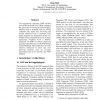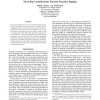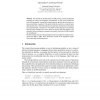EACL
1993
ACL Anthology
14 years 8 months ago
1993
ACL Anthology
In Data Oriented Parsing (DOP), an annotated corpus is used as a stochastic grammar. An input string is parsed by combining subtrees from the corpus. As a consequence, one parse t...
ACL
1993
14 years 8 months ago
1993
We describe a generative probabilistic model of natural language, which we call HBG, that takes advantage of detailed linguistic information to resolve ambiguity. HBG incorporates...
ACL
2000
14 years 8 months ago
2000
This paper reports the first part of a project that aims to develop a knowledge extraction and knowledge discovery system that extracts causal knowledge from textual databases. In...
EACL
2003
ACL Anthology
14 years 8 months ago
2003
ACL Anthology
Two apparently opposing DOP models exist in the literature: one which computes the parse tree involving the most frequent subtrees from a treebank and one which computes the parse...
NIPS
2008
14 years 8 months ago
2008
We develop the syntactic topic model (STM), a nonparametric Bayesian model of parsed documents. The STM generates words that are both thematically and syntactically constrained, w...
ACL
2008
14 years 8 months ago
2008
Among syntax-based translation models, the tree-based approach, which takes as input a parse tree of the source sentence, is a promising direction being faster and simpler than it...
FLAIRS
2007
14 years 9 months ago
2007
This paper describes the use of two machine learning techniques, naive Bayes and decision trees, to address the task of assigning function tags to nodes in a syntactic parse tree....
ESOP
2009
Springer
14 years 11 months ago
2009
Springer
We describe the mechanisation of SLR parsing, covering background properties of context-free languages and grammars, as well as the construction of an SLR automaton. Among the vari...
TOOLS
1992
IEEE
14 years 11 months ago
1992
IEEE
This paper describes an Ei el system for rapid testing of grammars. Grammars are de ned in an extended BNF notation that allows actions on the parse tree nodes to be de ned as add...
ICCAD
1999
IEEE
14 years 11 months ago
1999
IEEE
Identifying repeating structural regularities in circuits allows the minimization of synthesis, optimization, and layout e orts. We introduce in this paper a novel method for ident...



